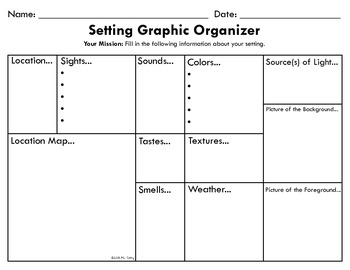Setting Graphic Organizer
- PDF
What educators are saying
Description
Students can utilize this versatile graphic organizer to collect essential information about a setting. Useful for both reading and writing lessons.
Common Core State Standards
CCSS.ELA-Literacy.RL.3.7 Explain how specific aspects of a text’s illustrations contribute to what is conveyed by the words in a story (e.g., create mood, emphasize aspects of a character or setting)
(RL.3.8 not applicable to literature)
CCSS.ELA-Literacy.RL.3.9 Compare and contrast the themes, settings, and plots of stories written by the same author about the same or similar characters (e.g., in books from a series)
CCSS.ELA-Literacy.RL.4.3 Describe in depth a character, setting, or event in a story or drama, drawing on specific details in the text (e.g., a character’s thoughts, words, or actions).


